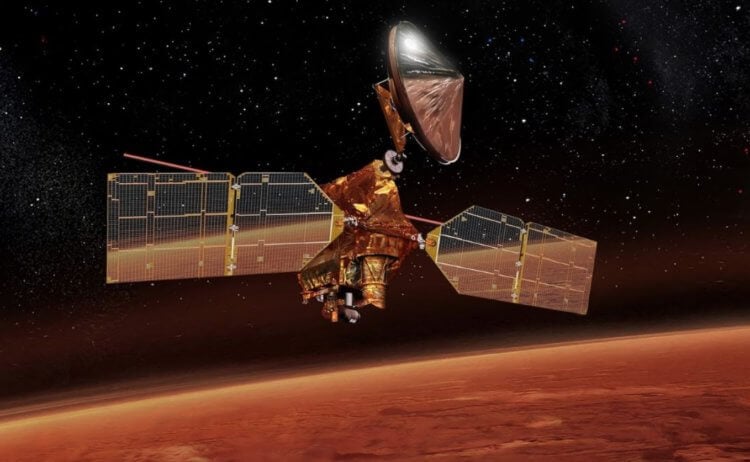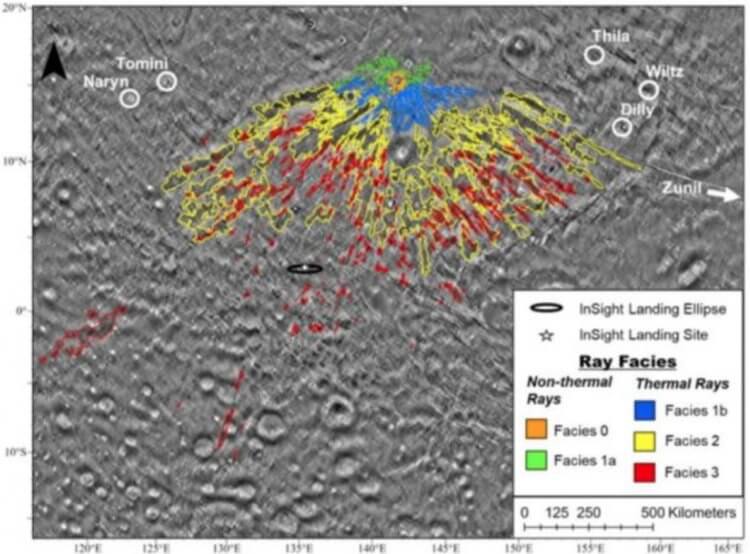Craters are depressions on the surface of planets that are formed as a result of falling space objects. To date, researchers know about theexistence of 128 craters on Earth, and the largest of them is Vredefort. It is located 120 kilometers from the city of Johannesburg in the Republic of South Africa and has a diameter of 300 kilometers. Perhaps there could be more craters on our planet, but they are quickly disappearing due to winds, rains, earthquakes and other natural phenomena. But on Mars there are much fewer such phenomena and, therefore, there are a lot of craters there. Recently, scientists have found that not all of them were formed directly after the fall of the asteroid. Approximately 2 billion Martian craters appeared due to debris flying in different directions.

Martian crater Corinto. Image: phys.org
Carter Corinto on Mars
As part of a new scientific work, the results of which were reported by the authors of the scientific publication Science Alert, scientists studied the Corinto crater. It is located on the Elysium Plain, north of the equator of Mars. Calculations show that this is a relatively young crater, whichwas formed approximately 2.34 million years ago.Its diameter is 14 kilometers and its depth reaches 1 kilometer. Based on this, we can conclude that the depression was formed after the fall of a large asteroid.
Interesting fact:Scientists believe that the Martian crater Corinto is the most recent of the large craters. According to statistics, large objects capable of leaving such a large depression fall on Mars only once every 3 million years.

The process of studying the fall of a mysterious asteroid on Mars
During the study of this crater, scientists suggested that the asteroid that created it was full of water ice at the time of impact. Judging by the nature of the depression, the space object fell at a steep angle of about 45 degrees and was moving from the north. As a result of the collision, a huge number of fragments of the destroyed asteroid were thrown to the south – scientists call them “ejections.”
Article on the topic:What is an impact crater and which of them is the largest in the Solar System?
How are small craters formed
After studying photographs taken by the Mars Reconnaissance Orbiter (MRO), scientists tried to find smaller craters that could have been formed due to the fall of these same emissions. The work bore fruit – scientists managed tofind about 2 billion craters on Mars, who can be considered the “children” of Corinto’s education. Almost all of them have a diameter of more than 10 meters, that is, they cannot be called small and they are clearly visible on satellite images.

Mars Reconnaissance Orbiter interplanetary station. Image: spaceflightinsider.com
The authors of the scientific work came to the conclusion that after the formation of the Corinto crater, fragments of an unknown asteroid scattered over a distance of up to 1850 kilometers. According to the researchers, this scientific discovery shows that we still do not know much about the processes that took place on Mars millions of years ago. The Red Planet is strewn with various craters, and scientists have yet to learn the history of their origin.

Colored dots indicate small craters formed as a result of falling emissions
Read also: Why Should there be more craters on the Moon than there are now?
Studying Martian craters
It goes without saying that scientists will not be able to name billions of craters. However, there are depressions on the surface of Mars that not only have their own names, but also have a very interesting history and are of particular interest to scientists.
An example is the Jezero crater, whose diameter reaches 49 kilometers. It is believed that millions of years ago this depression was filled with liquid water. And where there was water, living creatures could live – at least bacteria could swim in it. That is why in 2021 the Perseverance rover was landed on the bottom of the Jezero Crater. Today the device is busy collecting soil samples. Around the 2030s, the collected materials will be sent to Earth so that scientists can study them in the laboratory. There is hope that in these samples we will be the first to find traces of alien life. We may find out that we are not alone in the Universe, and this is extremely intriguing.

Jezero Crater on Mars. Photo: scitechdaily.com
Be sure to subscribe to our Zen and Telegram channels. This way you won't miss any important news!
There are craters on almost all space objects, even on satellites and asteroids. There are no perfectly smooth planets, because collisions constantly occur in space. Scientists carefully study all these formations and regularly tell something interesting about them. For example, in 2022, thanks to the work of scientists, we learned what happens in the dark craters of the Moon, where light does not penetrate. There is also an article on our website about a crater on Mars that is filled with precious stones. We strongly recommend reading!